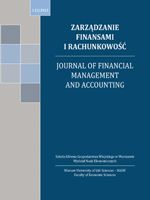Main Article Content
Article Details
BAKER M., WURGLER J. 2000: The equity share in new issues and aggregate stock returns. Journal of Finance 55 (5), p.p. 2219-2257. (Crossref)
Bernat A.K. 2015: Luka finansowa w sektorze mikro, małych i średnich przedsiębiorstw na przykładzie województwa świętokrzyskiego, CeDeWU, Warszawa.
BHAMA V., JAIN P.K., YADAV S.S. 2015: Does Firms' Pecking Order Vary during Large Deficits and Surpluses? An Empirical Study on Emerging Economies. Procedia Economics and Finance, 30, p.p. 155-163. (Crossref)
CHEN D.H., CHEN C.D., CHEN J., HUANG Y.F. 2013: Panel data analyses of the pecking order theory and the market timing theory of capital structure in Taiwan. International Review of Economics & Finance, 27, p.p. 1-13. (Crossref)
CZEKAJ J., DRESLER Z. 2011: Zarządzanie finansami przedsiębiorstw. PWN, Warszawa.
DAMODARAN A. (2007): Finanse korporacyjne. Teoria i praktyka - wydanie II, Wydawnictwo Helion, Gliwice.
DAMIJAN J.P., KOSTEVC C., POLANEC S. 2015: Access to finance, exporting and a nonmonotonic firm expansion. Empirica, 42 (1) p.p. 131-155. (Crossref)
FAZZARI S.M., HUBBARD R.G., PETERSEN B.C., BLINDER A.S., POTERBA J.M. 1988: Financing constraints and corporate investment; comments and discussion. Brookings Papers on Economic Activity, 1 p.p. 141-206. (Crossref)
FRANK M.Z., GOYAL V. K. 2003: Testing the pecking order theory of capital structure. Journal of Financial Economics, 67, p.p. 217-248. (Crossref)
GABRUSEWICZ W., REMLEIN M. 2011: Sprawozdanie finansowe przedsiębiorstwa jednostkowe i skonsolidowane, PWE, Warszawa.
HILL T., LEWICKI P. 2006: Statistics - Methods and Applications. Statsoft, Tulsa, USA.
JANASZ K., JANASZ W., WIŚNIEWSKA J. 2005: Zarządzanie kapitałem w przedsiębiorstwie. Difin, Warszawa.
KRZEMIŃSKA D. 2005: Finanse przedsiębiorstwa. Wydawnictwo WSB, Poznań.
LIESZ T.J. 2002: Why Pecking Order Theory Should be Included in Introductory Finance Courses. Mesa State College: School of Business & Professional Studies.
LINO S. 2007: New pecking order financing for innovative firms: an overview. Working Paper Series, No. 2/2007, Universitŕ di Torino, p.p. 1-28.
LÓPEZ-GUTIÉRREZ C., SANFILIPPO-AZOFRA S., TORRE-OLMO B. 2015: Investment decisions of companies in financial distress. BRQ Business Research Quarterly, 18 (3), p.p. 174-187. (Crossref)
LOUGHRAN T., RITTER J.R. 1995: The new issues puzzle. Journal of Finance, 50 (1), p.p. 23-51 (Crossref)
MICHALAK A. 2007: Finansowanie inwestycji w teorii i praktyce. PWN, Warszawa.
MYERS S.C., MAJLUF N. 1984: Corporate financing and investment decision when firms have information that investors do not have. Journal of Financial Economics, 13, 2, p.p. 187-221. (Crossref)
PIASECKI B. 1998: Ekonomika i zarządzanie małą firmą. PWN, Warszawa.
SASKIA C., FLOR C.R. 2015: The impact of assets-in-place on corporate financing and investment decisions, Journal of Banking & Finance, 61, p.p. 64-80. (Crossref)
SAUNER-LEROY J.B. 2004: Managers and productive investment decisions: The impact of uncertainty and risk aversion. Journal of Small Business Management, 42 (1), p.p. 1-18. (Crossref)
SHEIKH J., AHMED W.A., IQBAL W., MASOOD M.M. 2012: Peckin p.p. g at pecking order theory: Evidence from pakistan's non-financial sector. Journal of Competitiveness, 4 (4), p.p. 86-95. (Crossref)
SOSIŃSKA-WIT M. 2011: Inwestycje MŚP czynnikiem wzrostu wartości majątku przedsiębiorstw województwa lubelskiego na podstawie wyników badań ankietowych. Zesz. Nauk. WSEI seria: EKO, 3, s. 141-159.
SKOWRONEK-MIELCZAREK A. 2007: Małe i średnie przedsiębiorstwa - źródła finansowania. Wydawnictwo C.H. Beck, Warszawa.
SPIESS D.K., AFFLECK-GRAVES J. 1995: Under-performance in long-run stock returns following seasoned equity offerings. Journal of Financial Economics, 38 (3), p.p. 243-267. (Crossref)
TITMAN S., WESSELS R. 1988: The determinants of capital structure. The Journal of Finance, 43, 1, p.p. 1-19. (Crossref)
VANACKER T.R., MANIGART S. 2010: Pecking order and debt capacity considerations for high-growth companies seeking financing. Small Business Economics, 35 (1), p.p. 53-69. (Crossref)
WYMYSŁOWSKI S. 2004: Kryteria wyboru źródeł finansowania działalności rozwojowej - teoria i praktyka. Finansowanie rozwoju organizacji gospodarczych, Difin, Warszawa.LW
Downloads
- Magdalena Mądra-Sawicka, The importance of internal sources of financing regard to capital structure decisions in agricultural enterprises , Zarządzanie Finansami i Rachunkowość : Vol. 3 No. 4 (2015)
- Magdalena Mądra-Sawicka, Aneta Kalisiak, The capital structure of the construction companies listed and non-listedon stock exchanged , Zarządzanie Finansami i Rachunkowość : Vol. 5 No. 2 (2017)




